biochemical and haematological profile - Universitatea de Ştiinţe ...
biochemical and haematological profile - Universitatea de Ştiinţe ...
biochemical and haematological profile - Universitatea de Ştiinţe ...
Create successful ePaper yourself
Turn your PDF publications into a flip-book with our unique Google optimized e-Paper software.
<strong>Universitatea</strong> <strong>de</strong> Științe Agricole și Medicină Veterinară Iași<br />
7. Diffuse corneal e<strong>de</strong>ma 8. Localized corneal e<strong>de</strong>ma<br />
When it appears, corneal vascularization is always pathological. Blood vessels can be<br />
superficial, <strong>de</strong>ep or both. Superficial neovascularisation are „treelike” vesseles, originating in<br />
conjunctival circulation. They occur whenever there is a lesion in the epithelium or the<br />
anterior stroma. Deep vessels are short, parallel, „hedgelike”, originating in the cilliary<br />
circulation. The <strong>de</strong>pth of new formed vessels is a good indicator of the <strong>de</strong>pth of the initiating<br />
lesion. In cases of persistent or complicated lesions, a granulation tissue can occur. The<br />
CHUVA‐ENVA<br />
dinamic of corneal neovascularisation is presented in photos 9‐14.<br />
9.Superficial neovascularisation, cat. 10.Superficial vessels, cat. 11. Superficial vessels, dog.<br />
CHUVA‐ENVA<br />
12. Granulation tissue, dog. 13. Granulation tissue, cat 14.Deep vascularisation, dog.<br />
Corneal vascularisation is generally beneficial in stromal repair. Blood vessels advance from<br />
the limbus, until they inva<strong>de</strong> the lesion, corneal healing <strong>and</strong> regain of transparency starting<br />
from the limbus, as it can be seen in photo 9. Keeping in mind those facts, although blood<br />
vessels can result in influx of pigments <strong>and</strong> inflammatory cells, easing corneal fibrosis, control<br />
if neovascularisation with the use of steroids is not always indicated.<br />
Corneal pigmentation is also called pigmentary keratitis. These terms ignore the possibility of<br />
other pigments, like hemoglobin or the soluble pigment in corneal sequestra in cats, than<br />
melanin to cause corneal opacity. Nevertheless, it must not be used as a diagnosis, for it is only<br />
a sign of chronic, persistent corneal irritation, that may have many causes, each with a<br />
different treatment. Melanin is <strong>de</strong>posited in the epithelium <strong>and</strong> the anterior stroma, migrating<br />
along with blood vessels, during the inflammatory process.<br />
Corneal melanosis is a sign of chronic irritation, as seen in cases of eye exposure due to facial<br />
nerve paralysis, lagophtalmos, frictional irritation (distichiasis, entropion) (photo. 15), tear film<br />
CHUVA‐ENVA<br />
32<br />
CHUVA‐ENVA<br />
CHUVA‐ENVA<br />
CHUVA‐ENVA<br />
CHUVA‐ENVA




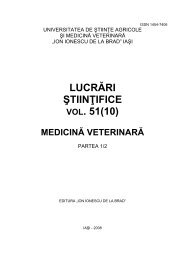

![rezumat teză [RO]](https://img.yumpu.com/19764796/1/190x245/rezumat-teza-ro.jpg?quality=85)




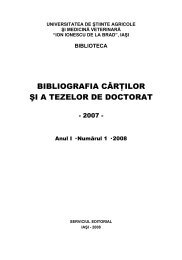
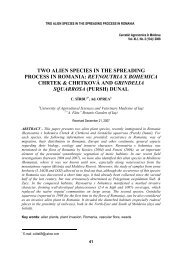
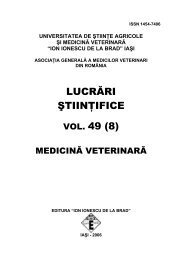
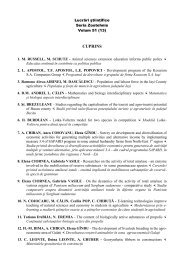

![rezumat teză [RO] - Ion Ionescu de la Brad](https://img.yumpu.com/14613555/1/184x260/rezumat-teza-ro-ion-ionescu-de-la-brad.jpg?quality=85)
